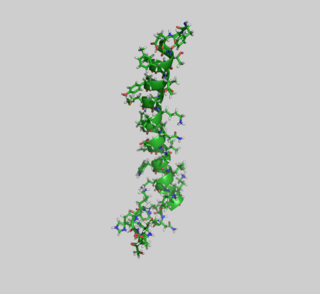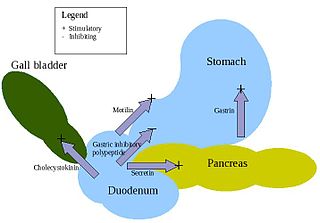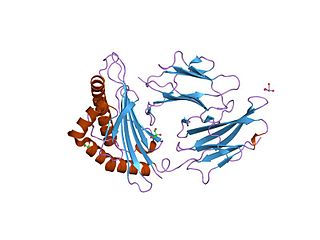
Secretin is a hormone that regulates water homeostasis throughout the body and influences the environment of the duodenum by regulating secretions in the stomach, pancreas, and liver. It is a peptide hormone produced in the S cells of the duodenum, which are located in the intestinal glands. In humans, the secretin peptide is encoded by the SCT gene.

Glucagon is a peptide hormone, produced by alpha cells of the pancreas. It raises the concentration of glucose and fatty acids in the bloodstream and is considered to be the main catabolic hormone of the body. It is also used as a medication to treat a number of health conditions. Its effect is opposite to that of insulin, which lowers extracellular glucose. It is produced from proglucagon, encoded by the GCG gene.

Somatostatin, also known as growth hormone-inhibiting hormone (GHIH) or by several other names, is a peptide hormone that regulates the endocrine system and affects neurotransmission and cell proliferation via interaction with G protein-coupled somatostatin receptors and inhibition of the release of numerous secondary hormones. Somatostatin inhibits insulin and glucagon secretion.

Digestive enzymes take part in the chemical process of digestion, which follows the mechanical process of digestion. Food consists of macromolecules of proteins, carbohydrates, and fats that need to be broken down chemically by digestive enzymes in the mouth, stomach, pancreas, and duodenum, before being able to be absorbed into the bloodstream. Initial breakdown is achieved by chewing (mastication) and the use of digestive enzymes of saliva. Once in the stomach further mechanical churning takes place mixing the food with secreted gastric acid. Digestive gastric enzymes take part in some of the chemical process needed for absorption. Most of the enzymatic activity, and hence absorption takes place in the duodenum.

Vasoactive intestinal peptide, also known as vasoactive intestinal polypeptide or VIP, is a peptide hormone that is vasoactive in the intestine. VIP is a peptide of 28 amino acid residues that belongs to a glucagon/secretin superfamily, the ligand of class II G protein–coupled receptors. VIP is produced in many tissues of vertebrates including the gut, pancreas, cortex, and suprachiasmatic nuclei of the hypothalamus in the brain. VIP stimulates contractility in the heart, causes vasodilation, increases glycogenolysis, lowers arterial blood pressure and relaxes the smooth muscle of trachea, stomach and gallbladder. In humans, the vasoactive intestinal peptide is encoded by the VIP gene.

Gastric inhibitory polypeptide(GIP), also known as glucose-dependent insulinotropic polypeptide, is an inhibiting hormone of the secretin family of hormones. While it is a weak inhibitor of gastric acid secretion, its main role, being an incretin, is to stimulate insulin secretion.

Proglucagon is a protein that is a precursor of glucagon and several other components. It is cleaved from preproglucagon. Proglucagon is generated in the alpha cells of the pancreas and in the intestinal L cells in the distal ileum and colon.
Somatostatinomas are a tumor of the delta cells of the endocrine pancreas that produces somatostatin. Increased levels of somatostatin inhibit pancreatic hormones and gastrointestinal hormones. Thus, somatostatinomas are associated with mild diabetes mellitus, steatorrhoea and gallstones, and achlorhydria. Somatostatinomas are commonly found in the head of pancreas. Only ten percent of somatostatinomas are functional tumours [9], and 60–70% of tumours are malignant. Nearly two-thirds of patients with malignant somatostatinomas will present with metastatic disease.
The gastrointestinal hormones constitute a group of hormones secreted by enteroendocrine cells in the stomach, pancreas, and small intestine that control various functions of the digestive organs. Later studies showed that most of the gut peptides, such as secretin, cholecystokinin or substance P, were found to play a role of neurotransmitters and neuromodulators in the central and peripheral nervous systems.

Enteroendocrine cells are specialized cells of the gastrointestinal tract and pancreas with endocrine function. They produce gastrointestinal hormones or peptides in response to various stimuli and release them into the bloodstream for systemic effect, diffuse them as local messengers, or transmit them to the enteric nervous system to activate nervous responses. Enteroendocrine cells of the intestine are the most numerous endocrine cells of the body. They constitute an enteric endocrine system as a subset of the endocrine system just as the enteric nervous system is a subset of the nervous system. In a sense they are known to act as chemoreceptors, initiating digestive actions and detecting harmful substances and initiating protective responses. Enteroendocrine cells are located in the stomach, in the intestine and in the pancreas. Microbiota play key roles in the intestinal immune and metabolic responses in these enteroendocrine cells via their fermentation product, acetate.

The secretin receptor is a protein that in humans is encoded by the SCTR gene. This protein is a G protein-coupled receptor which binds secretin and is the leading member of the secretin receptor family, also called class B GPCR subfamily.

Peptide PHI, also known as peptide histidine isoleucine, is a peptide which functions as a hormone. This peptide contains a composition of 27 amino acids with histidine on the N-terminus and isoleucine on the C-terminus. It was originally isolated from the mammalian small intestine amongst mammalian neurons called intramural neurons which function in the motor activity of the intestinal walls. An example of this was revealed in a study that demonstrated that this peptide regulates water and electrolyte transportation in the human jejunum; similar to its inhibitory effects on fluid absorption in the small intestine of pigs and rats.

The gastric inhibitory polypeptide receptor (GIP-R), also known as the glucose-dependent insulinotropic polypeptide receptor, is a protein that in humans is encoded by the GIPR gene.
The glucagon receptor family is a group of closely related G-protein coupled receptors which include:

Pituitary adenylate cyclase-activating polypeptide type I receptor also known as PAC1, is a protein that in humans is encoded by the ADCYAP1R1 gene. This receptor binds pituitary adenylate cyclase activating peptide.

Vasoactive intestinal peptide receptor 2 also known as VPAC2, is a G-protein coupled receptor that in humans is encoded by the VIPR2 gene.

Vasoactive intestinal polypeptide receptor 1 also known as VPAC1, is a protein, that in humans is encoded by the VIPR1 gene. VPAC1 is expressed in the brain (cerebral cortex, hippocampus, amygdala), lung, prostate, peripheral blood leukocytes, liver, small intestine, heart, spleen, placenta, kidney, thymus and testis.
Secretin receptor family consists of secretin receptors regulated by peptide hormones from the glucagon hormone family. The family is different from adhesion G protein-coupled receptors.

Aviptadil is an injectable synthetic formulation of human vasoactive intestinal peptide (VIP). VIP was discovered in 1970, and has been used to treat various inflammatory conditions, such as acute respiratory distress syndrome (ARDS), asthma, and chronic obstructive pulmonary disease (COPD).
Local hormones are a large group of signaling molecules that do not circulate within the blood. Local hormones are produced by nerve and gland cells and bind to either neighboring cells or the same type of cell that produced them. Local hormones are activated and inactivated quickly. They are released during physical work and exercise. They mainly control smooth and vascular muscle dilation. Strength of response is dependent upon the concentration of receptors of target cell and the amount of ligand.













